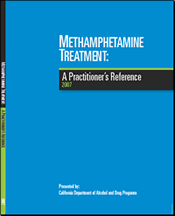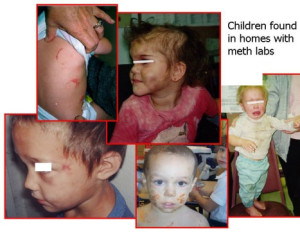 Meth dependence is a difficult disorder to treat. The following characterization of the clinical challenges of treating meth users is condensed from CSAT TIP #33. Withdrawal from meth dependence is characterized by a protracted anhedonia and dysphoria that is accompanied by severe craving for the drug. Craving frequently occurs in response to exposure to conditioned cues (stimuli present during past episodes of meth use and euphoria). Such cues evoke powerful craving for meth via classical conditioning principles. The likelihood of continued meth smoking or injecting appears to be, in part, related to the strength of the craving experienced from these craving-generating cues. The withdrawal dysphoria present in the context of ubiquitous meth availability and ubiquitous conditioned cues can produce a very pernicious dependence; indeed, inpatient hospitalization may be indicated to treat long-term meth dependence, at least in initial stages of detoxification. Medically managed inpatient care is expensive, however, and widespread meth abuse has appeared in impoverished populations with very limited access to such inpatient resources.
Meth dependence is a difficult disorder to treat. The following characterization of the clinical challenges of treating meth users is condensed from CSAT TIP #33. Withdrawal from meth dependence is characterized by a protracted anhedonia and dysphoria that is accompanied by severe craving for the drug. Craving frequently occurs in response to exposure to conditioned cues (stimuli present during past episodes of meth use and euphoria). Such cues evoke powerful craving for meth via classical conditioning principles. The likelihood of continued meth smoking or injecting appears to be, in part, related to the strength of the craving experienced from these craving-generating cues. The withdrawal dysphoria present in the context of ubiquitous meth availability and ubiquitous conditioned cues can produce a very pernicious dependence; indeed, inpatient hospitalization may be indicated to treat long-term meth dependence, at least in initial stages of detoxification. Medically managed inpatient care is expensive, however, and widespread meth abuse has appeared in impoverished populations with very limited access to such inpatient resources.
Psychosocial/Behavioral Treatments
Presently, there are two approaches that have evidence to support their efficacy for the treatment of meth dependence, but there is a much larger literature on treatments that work with the other major illicit stimulant problem in the U.S., cocaine dependence. Although there are a number of differences in the pharmacology and physiological effects produced by meth and cocaine, these drugs have many common properties and similar effects. Research examining the treatment responses of meth and cocaine users suggests that cocaine and meth users have very similar outcomes when exposed to the same treatments. In addition, large scale treatment system evaluations have reported comparable outcomes for cocaine and meth users.
Matrix Model
During the 1980s, the Matrix Institute on Addictions group in Southern California created a multi-element treatment manual with funding support from NIDA, designed for application with stimulant users on an outpatient basis. The Matrix approach evolved over time, incorporating treatment elements with support from scientific evidence, including cognitive behavioral therapies (i.e., relapse prevention techniques), a positively reinforcing treatment context, many components of motivational interviewing, family involvement, accurate psychoeducational information,12-step facilitation efforts, and regular urine testing. The approach is delivered using a combination of group and individual sessions delivered approximately three times per week over a 16 week period followed by a 36 week continuing care support group and 12 step program participation. Over 15,000 cocaine and meth users have been treated with this approach during the past 20 years. The manual and related materials have been published by Hazelden and SAMHSA. (for more details see www.Hazelden.org, www.SAMHSA.gov, and Matrix Institute)
Matrix Treatment
In 1999, CSAT funded a large scale evaluation of the Matrix Model for the treatment of meth users coordinated by UCLA. Roughly 1,000 meth dependent individuals were admitted into eight different treatment study sites. In each of the eight sites, 50% of the participants were randomly assigned to either Matrix treatment or to a “treatment as usual” (TAU) condition, which was comprised of a variety of counseling techniques idiosyncratic to each site. The study results showed that individuals assigned to treatment in the Matrix approach received substantially more treatment services, were retained in treatment longer, gave more meth-negative urine samples during treatment and completed treatment at a higher rate than those in the TAU condition. These in-treatment data suggested a superior response to the Matrix approach. When data at discharge and follow up were examined, it appeared that both treatment conditions produced comparable post-treatment outcomes. Participants in both conditions showed very significant reductions in meth use, significant improvements in psychosocial functioning, and substantial reductions in psychological symptoms, including depression. Follow up data indicated that over 60 percent of both treatment groups reported no meth use and gave urine samples that tested negative for meth (and cocaine) use. Use of other drugs, such as alcohol and marijuana were also significantly reduced.
A particularly interesting finding was that across the eight treatment sites, the ‘drug court site’, e.g., the one that enrolled individuals who were participating under a drug court program, produced superior results compared to the other seven sites, suggesting a substantial beneficial influence of drug court involvement. Overall, this evaluation is the largest controlled study of meth treatments that has ever been conducted.
Contingency Management (CM). Positive reinforcement is a powerful tool in increasing desired behaviors. School teachers who give ‘special prizes’ for superior performance, companies who give employee incentive bonuses for meeting production goals, AA meetings that give ‘chips’ and cakes to acknowledge successful progress in achieving sobriety are all examples of the effective use of positive reinforcement. Many existing treatment programs informally use positive reinforcement as part of their treatment milieu. Frequently, the reinforcement takes the form of verbal praise, or earning program privileges, or ‘graduating’ to a higher level of status in the program or some other practice to acknowledge and reward progress in treatment. CM is simply the systematic application of these same reinforcement principles. In many of the studies investigating CM approaches, treatment participants can earn ‘vouchers’ that are exchangeable for non-monetary desired items (e.g., free movie tickets, restaurant dinners, grocery vouchers, gasoline coupons, etc.). Typically the individual can earn larger valued rewards for longer periods of continuous abstinence from drugs and alcohol.
Over the past 30 years, a number of researchers and research groups at Johns Hopkins (Stitzer, Silverman), Vermont (Higgins and colleagues), Connecticut (Petry and colleagues), and UCLA (Roll and colleagues) have demonstrated the powerful effect of CM techniques to reduce heroin, benzodiazepine, cocaine and nicotine use. Recently CM techniques have been implemented with meth users in Southern California by the group at UCLA and by researchers in the NIDA Clinical Trials Network. The results of these investigations have provided powerful support to the efficacy of this behavioral strategy as treatment for meth abuse. Individuals who have been assigned to CM conditions have shown better retention in treatment, lower rates of meth use and longer periods of sustained abstinence over the course of their treatment experience. Without question, CM is a powerful technique that can play an extremely valuable role in improving the treatment response of meth-dependent individuals.
Medications
Research efforts to develop medications to aid in the treatment of meth-related disorders are at a relatively early stage of development. Currently there are no medications that can quickly and safely reverse life threatening meth overdoses. Similarly, there are no medications that can reliably reduce the paranoia and psychotic symptoms that frequently contribute to episodes of dangerous and violent behavior associated with meth use. As clinicians will attest, it would be tremendously helpful to have medications that could help meth users recover more quickly from the effects of chronic use. Medication(s) that could reduce symptoms in the early days and weeks of recovery could be extremely valuable in promoting engagement and retention in behavioral and psychosocial treatments.
The problem of relapse to meth use is a complex process. However, one important set of contributing factors is the unpleasant emotional and cognitive impairments that accompany the protracted abstinence syndrome for months after meth use is discontinued. Medications that could lessen the severity of these symptoms could be of tremendous value in providing more successful treatments. At present, there have been fewer than 10 placebo-controlled double-blind efficacy trials of potential meth pharmacotherapies. One of the limiting factors in rapidly evaluating medications for meth-related disorders is that there are relatively few experienced pharmacotherapy research groups in the midwestern and western geographical areas impacted by meth. The need to develop new research groups capable of conducting addiction pharmacotherpy groups west of the Mississippi is a critical need to increase the pace of medication development.
In response to this need, the National Institute on Drug Abuse (NIDA) has recently established the Methamphetamine Clinical Trials Group (MCTG), a network designed to provide new clinical research teams and sites in geographic areas where meth use is a major public health problem. This network funded by NIDA, consists of sites in San Diego and Costa Mesa, California, Honolulu, Hawaii, Des Moines, Iowa and Kansas City, Missouri and a coordinating center at UCLA. Studies of promising pharmacotherapies will be moved into these sites for assessment in double-blind, placebo-controlled trials.
Links



